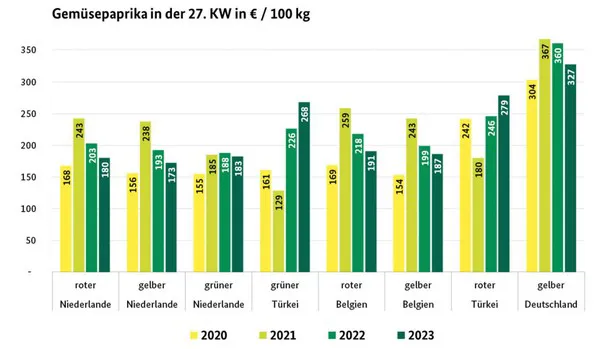Dutch sweet peppers obviously dominated. Turkish imports followed in terms of importance. Belgian goods complemented the market but were absent in Munich and Berlin. In Frankfurt, Italian pointed peppers appeared, which cost €2,- per kg. Domestic batches continued to be at the top of the price list: customers were expected to pay up to €4.30 per kg for them. Overall, availability had expanded, according to the BLE.

Meanwhile, the accommodation options remained unchanged. Demand was, therefore, somewhat too weak for supply. In some places, there were stocks, which the distributors countered by granting discounts. In particular, items from the Netherlands had to be handled with reductions. The falling valuations at least accelerated the liquidation afterwards.
Click here for the complete market and price report.
Apples
The presence of New Zealand and Chilean imports expanded steadily. New arrivals were Chilean Red Delicious and Cripps Pink, as well as New Zealand Jazz. Braeburn from New Zealand, Pink Lady from Chile, and Granny Smith from South Africa gained noticeably in importance. The new season was already heralded with the first Lodi from Germany: the fruit was to cost €3,- per kg in Berlin.
Pears
Chilean and South African unloadings formed the basis of the supply, which was supplemented by Argentinean deliveries. A few Belgian, Dutch, and Turkish products only played a selective role. The trade was unagitated and very quiet.
Table grapes
The presence of Italian Black Magic and Victoria intensified. The already established fruits were flanked by Rad Magic and Flame Seedless. The first Italia appeared in Berlin. Spanish deliveries had also increased: Arra 30, Superior Seedless, Ralli Itum 15 as well as Scarlett Dew were available.
Strawberries
Local fruits continued to dominate, but the deliveries lost some of their strength. Dutch, Belgian, and Polish produce complemented the action. Availability had become more limited. The result was a slight increase in prices. Sometimes the price increases were significant.
Peaches and nectarines
Spanish deliveries were obviously predominant. Unloadings from Italy complemented this, while deliveries from France and Greece only played a minor role. Turkish fruits were not consistently convincing in terms of their organoleptic properties and therefore generated little attention.
Apricots
French and Spanish offers formed the basis of the range. Italian deliveries followed in terms of importance. Products from the Republic of Moldova, Hungary and Greece played only a small role. Local articles completed the scene, costing between €4.80 and €6,- per kg in Frankfurt.
Cherries
Local and Turkish offers predominated. They were flanked by consignments from Italy, Spain, and Greece with somewhat cheaper items. New arrivals from Poland, Belgium, Slovakia, and the Netherlands joined the assortment, but all of them were of limited importance. The demand was quite friendly.
Lemons
South African Eureka and Spanish Verna shared the action. Eureka from Argentina appeared in Hamburg during the week. Overall, supply and demand were sufficiently balanced.
Bananas
The supply was sufficiently adjusted to the accommodation possibilities. In some places, demand had weakened slightly due to the holidays. Nevertheless, valuations generally remained at the previous level. In Frankfurt, offers with too wide a ripening range provided discounts.
Cauliflower
Domestic unloadings predominated and were available like a monopoly in some places. Dutch and Belgian articles supplemented the event on a selective basis. With the help of extended availability, demand was easily met. Sometimes demand was even a little too weak.
Salads
In line with the season, domestic batches predominated in the entire lettuce segment. For lettuce, Belgian and Dutch batches were added, and for iceberg lettuce, Dutch and Polish offers were available. In general, the quality was quite convincing.
Cucumbers
The assortment consisted exclusively of German, Dutch, and Belgian deliveries. Overall, availability was limited and generally rather scarce. Due to promotions of the food retailer, considerable quantities were bound to the food retailer. Valuations tended upwards, mostly quite strong.
Tomatoes
Dutch and Belgian lots predominated. In terms of relevance, domestic, Italian, and Polish batches followed. Unloading had apparently increased, especially since panicles were delivered more frequently. Demand could hardly keep up with the increased availability, so there were more frequent reductions.
Source: BLE
